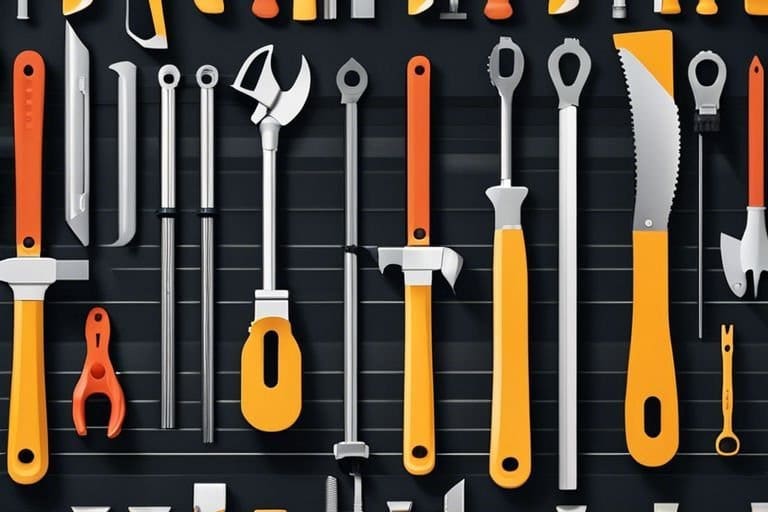There’s nothing quite like the satisfaction of using uncommon tools in your workshop to bring your projects to life. But with the excitement also comes the need for caution and proper safety measures. In this guide, we’ll walk you through the best practices for safely handling those unique tools that may not be as familiar to you. By following these tips, you can ensure that your workshop remains a safe and productive environment for all your DIY endeavors.
Understanding Uncommon Tools
Identifying Unfamiliar Tools in Your Workshop
Before using any unfamiliar tool in your workshop, it is imperative to first identify and understand what it is used for. Take the time to examine the tool visually and look for any labels or markings that could provide clues about its function. If the tool is in a case or packaging, read any accompanying instructions or manuals to gain a better understanding of its purpose.
Uncommon tools may have unique features or functions that differ from more common tools, so it is important to familiarize yourself with these differences before using them to ensure safe and proper usage.
Researching Tool Functions and Safety Precautions
Your next step in handling uncommon tools in your workshop should be to research their functions and any safety precautions associated with their use. Utilize resources such as manufacturer websites, online forums, or instructional videos to learn more about how the tool operates and any potential risks involved in using it.
The more you know about a tool and its intended use, the better prepared you will be to operate it safely and effectively. Always prioritize safety by following recommended guidelines and procedures when using any unfamiliar or uncommon tool.
The Importance of Proper Research
Essential Safety Tips for Handling Uncommon Tools
Assuming you have a workshop with a variety of tools, it is crucial to prioritize safety when handling uncommon tools. These tools may have unique features or functions that require special precautions to prevent accidents or injuries.
Wearing Protective Gear: A Must-Have for Tool Safety
One of the most important safety tips when handling uncommon tools is to always wear the appropriate protective gear. This gear may include safety goggles, gloves, ear protection, and even a helmet, depending on the tool being used. Protective gear is crucial for safeguarding yourself against potential hazards such as flying debris, loud noises, or sharp objects.
Creating a Safe Working Environment: Tips for Minimizing Risks
- Always ensure your workshop is well-lit to avoid accidents due to poor visibility.
- Keep your workspace clean and organized to prevent tripping hazards or clutter that could cause accidents.
Even with the proper protective gear, accidents can still happen if your working environment is not safe. Creating a safe workspace is crucial for minimizing risks and ensuring a smooth workflow in your workshop. By following simple tips to maintain a safe working environment, you can significantly reduce the chances of accidents or injuries.
- After using uncommon tools, always clean them properly and store them in their designated places.
Understanding Tool Manuals and Instruction Guides
Risks associated with uncommon tools can be minimized by thoroughly reading and understanding the tool manuals and instruction guides. These resources provide valuable information on how to safely operate the tool, as well as any potential risks or hazards to be aware of. By familiarizing yourself with the manufacturer’s guidelines, you can ensure that you are using the tool correctly and safely.
You should always refer to the tool manual for specific instructions on maintenance, storage, and any additional safety precautions that may apply to the tool you are using. Taking the time to understand these guidelines can help prevent accidents and prolong the lifespan of your tools.
Tips
It is crucial to keep the manuals and guides in a readily accessible location in your workshop for quick reference when needed. Make it a habit to consult these resources before using an uncommon tool, even if you have used similar tools in the past. Prioritizing safety and following the manufacturer’s recommendations can go a long way in preventing accidents and ensuring a secure working environment in your workshop.
Factors to Consider When Handling Uncommon Tools
- Tool Weight and Balance: How to Avoid Accidents
- Electrical Safety: Avoiding Shock and Fire Hazards
- Chemical Safety: Handling Tools with Hazardous Materials
Tool Weight and Balance: How to Avoid Accidents
Now, when handling uncommon tools with different weights and balances, it is crucial to pay attention to how you hold and maneuver them. Improper handling can lead to accidents such as dropping the tool on yourself or others, causing serious injuries. Make sure to familiarize yourself with the weight distribution of the tool and adjust your grip and stance accordingly for better control.
Electrical Safety: Avoiding Shock and Fire Hazards
An important factor to consider when using uncommon tools in your workshop is electrical safety. Always check the tool’s cords and connections for any damage before use. Ensure that the tool is properly grounded and never use it near water or wet surfaces to avoid electric shock. Additionally, be cautious of overheating issues that could potentially lead to fire hazards.
Knowing how to safely handle uncommon tools with electrical components can prevent accidents and keep your workshop a safe environment to work in.
Chemical Safety: Handling Tools with Hazardous Materials
Uncommon tools in your workshop may involve hazardous materials such as chemicals or cleaners. It is crucial to familiarize yourself with the proper handling and storage procedures for these tools to avoid any health risks. Always wear appropriate protective gear such as gloves and goggles when handling tools with hazardous materials to protect yourself from potential harm.
Handling uncommon tools with hazardous materials requires extra caution and adherence to safety protocols to prevent any accidents or injuries.
How to Handle Uncommon Tools with Care
Despite their uniqueness, uncommon tools should be handled with the same level of care and attention as more common tools in your workshop. In order to maintain a safe and efficient workspace, it’s important to learn how to handle these tools properly.
Proper Tool Storage: Preventing Damage and Accidents
Tool storage is imperative when it comes to uncommon tools. These tools are often more delicate or have specific storage requirements compared to regular tools. To prevent damage and accidents, make sure you store uncommon tools in a secure and designated space. Consider using protective cases or foam inserts to keep them safe from impact or environmental factors.
Tool Maintenance: Regular Checks for Safety and Efficiency
Damage can easily occur if uncommon tools are not properly maintained. Regular checks are imperative to ensure the safety and efficiency of these tools. Make it a habit to inspect uncommon tools for any signs of wear and tear, loose parts, or other issues that could affect their performance.
For instance, if you notice any rust or corrosion on metal parts, it’s important to address it immediately to prevent further damage. Keep blades sharp and clean, and lubricate moving parts as needed to ensure smooth operation.
Disposing of Uncommon Tools: Environmental and Safety Considerations
With uncommon tools, disposing of them requires special consideration due to their unique materials or components. Always check for any hazardous materials that may be present in the tool before disposing of it. Research proper disposal methods for uncommon tools to ensure you are following environmental regulations and keeping yourself safe.
Tool disposal should be done responsibly to minimize any negative impact on the environment. Consider recycling or donating tools that are still in good condition to prolong their useful life and reduce waste.
Advanced Safety Techniques for Uncommon Tools
- Using Safety Features: Guards, Shields, and Interlocks
For tools with specific safety features, it is important to familiarize yourself with how these features work and ensure they are always in place while operating the tool. - Implementing Emergency Procedures: What to Do in Case of an Accident
While working with uncommon tools, it is crucial to have a clear understanding of the emergency procedures in case of an accident. Make sure all workshop staff are trained on these protocols.
Advanced: In advanced safety training, workshops may simulate accidents to test response times and efficacy of emergency procedures. This hands-on approach can help workshop staff become more prepared for real-life emergencies and ensure a safer work environment.
Regular Safety Drills: Staying Prepared and Alert
Procedures: Regular safety drills should be conducted in the workshop to keep everyone sharp and prepared for emergency situations. These drills can include practicing using fire extinguishers, first aid procedures, and evacuations.
Using: Safety drills should be scheduled regularly and involve all workshop staff. By practicing these procedures, everyone can be more alert and confident in handling emergencies should they occur.
Common Mistakes to Avoid When Handling Uncommon Tools
Ignoring Safety Precautions: The Consequences of Complacency
To ensure safety in your workshop, it is crucial not to overlook safety precautions when using uncommon tools. Ignoring safety measures can lead to serious consequences, including accidents, injuries, and even potential hazards. The familiarity with common tools may breed complacency, making it easy to disregard safety guidelines when working with tools that are less frequently used.
Misusing Tools: How to Avoid Damage and Injury
Safety should always be a top priority when handling uncommon tools in your workshop. Misusing tools not only increases the risk of injury but also can cause damage to the tool itself. To avoid these pitfalls, take the time to familiarize yourself with the proper way to use each tool. Read the manufacturer’s instructions, watch tutorials, or seek guidance from experienced individuals to ensure you are using the tool correctly.
With proper knowledge and understanding of how to use uncommon tools, you can protect yourself from harm and prevent unnecessary wear and tear on the tools. Note, using tools incorrectly not only jeopardizes your safety but also shortens the lifespan of the equipment, potentially leading to costly repairs or replacements.
Overlooking Tool Maintenance: The Risks of Neglect
Regular maintenance is necessary for keeping tools in optimal working condition, yet it is a step that is often overlooked, especially when dealing with uncommon tools. Neglecting tool maintenance can result in decreased performance, unexpected malfunctions, and safety hazards in the workshop. Taking the time to inspect, clean, and lubricate your tools regularly can help prevent these issues and prolong the lifespan of your equipment.
Overlooking the importance of tool maintenance can lead to inefficiencies in your work, compromised safety, and ultimately, more expenses in the long run. By incorporating routine maintenance into your workshop practices, you can ensure that your uncommon tools are always ready for use and perform reliably when needed.
Conclusion
On the whole, using uncommon tools in your workshop can be a great way to expand your capabilities and take on unique projects. However, it is crucial to prioritize safety when working with these tools. By following the guidelines mentioned above, such as familiarizing yourself with the tool’s manual, wearing appropriate safety gear, and seeking guidance from experts, you can minimize the risk of accidents and injuries.
Remember that taking the time to educate yourself about how to safely handle uncommon tools is necessary for your well-being and the success of your projects. So, before submerging into using a new tool, make sure to do your research and take the necessary precautions. With the right approach, you can confidently and safely explore the exciting possibilities that come with using uncommon tools in your workshop.




